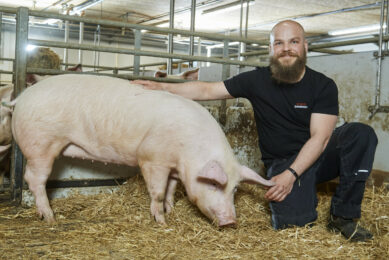Light (II): How much and for how long?

Pig Progress’ resident expert on ‘Pig Management’, John Gadd, takes the subject of light 1 step further in this series of 4 and talks about the amount of light needed for sows – and for how long.
In my last column I dealt with the effect of too much light from spring sunshine on outdoor and yarded sows, and then instruments for measuring light accurately which the farm staff can use. Where is sufficient light least understood? Primarily at and around breeding time and secondarily in the farrowing room.
Past advice, still seen today, has been ‘bright enough to read a paper’. In my experience this is still not bright enough and comes from the days when the breeding area, often linked with dry sow stalls, was far too dark and gloomy.
Simple & cheap remedy for barns with insufficient light
I still see it in outdated barns despite the remedy being simple and cheap, and not needing a complete building refurbishment or update. Too many farrowing rooms just have lights from heat lamps and natural light through and small heat-saving windows and ventilators, once feeding is over the lights are switched off when the staff leave. Not enough, as trials show that sufficient light in lactation has a carry-over effect into rebreeding as well as improving milk letdown, important in these days of large and hungry litters.
So how much light?
I’ve been working with light for 40 years using a light meter wherever I go. These are my experiences, whatever the welfare people say, as my callouts have been getting things like returns, weaning to service intervals and empty days better, and how light levels can affect them.
Taking lux rather than lumens (close enough to be interchangeable measurements) a bright sunny day outside will measure out at 500-600 lux and a starlit night about 20-25 lux. Aim to achieve at least 350 lux shining down into the sow’s eyes, not above and behind them for the breeding area and perhaps 300 lux illuminating the whole farrowing room; both for 14 to 16 hour periods in the 24 hour day.
Group housed sows – target light to favoured lying areas
You cannot get this sufficiently correct without a light meter and the proof of this sufficiency I will detail next month. Easy enough to get it spot-on when sows are aligned in stalls – more difficult in groups of sows in yards or outside pens. This is where the light meter helps as it can reveal the intensity of light falling on those areas where the sows tend to lie or forage, and the lighting can be adjusted towards these areas accordingly.
Farrowing house lighting
Similarly the farrowing house lighting can be altered to achieve the 300 lux for the requisite hours, governed by a time switch. As to hours of darkness, 20-25 lux for 8 hours seems correct, but in latitudes with very long summer days it only gets this dark for one to two hours. If so it needs at least some dimming down to 30 lux during the 6 to 8 hour ‘artificial night’.
Getting the balance of bright light and dimming right
In my experience it is not so much the level of light but the interface between definitely bright light and at least some degree of dimming which is important. This can be done by pulling down some shades to reduce the natural light from windows, but care must be taken not to obstruct air movement and so restrict the ventilation.
The light meter: essential but rarely used
Using a light meter avoids any arguments over incandescent/fluorescent strips and the latest varieties of high intensity lighting. Whatever you are advised to use, the light meter will tell you what the light intensity is near to the animal’s eyes and the lighting can be fixed to reach it. Of course there are dull days and bright days in any season, but the light meter will give you a good handle on what dosage the sow is receiving over a period. If the lighting is made bright enough, I don’t think these variations matter too much, but the jury seems out on this one.
Previous article
Light (I): Seasonal infertility











